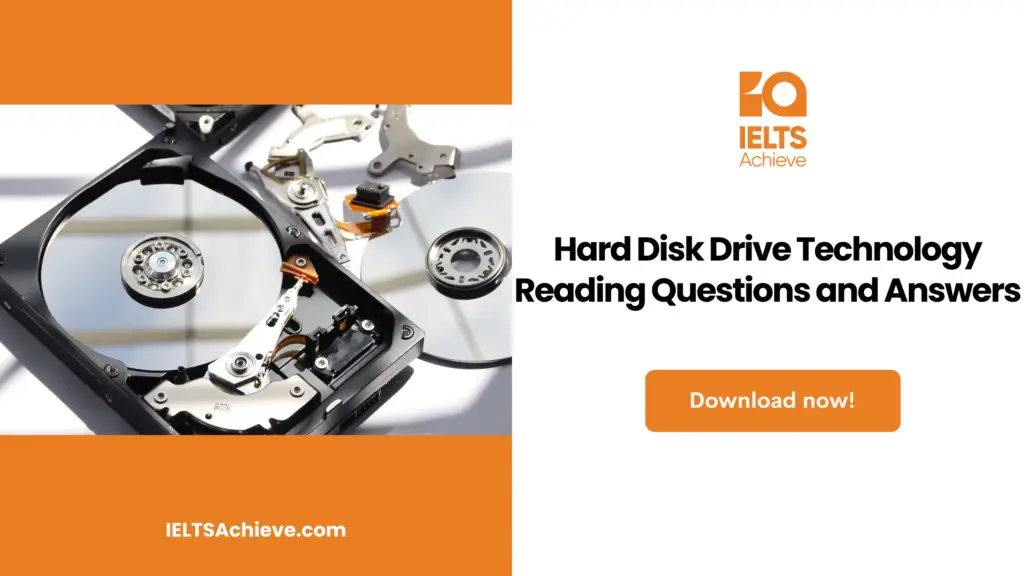The Blog post contains the following IELTS Reading Questions:
- IELTS Reading Multiple Choice Questions
- IELTS Reading Summary Completion
Stay informed and prepared for success – Explore our comprehensive Reading Test Info page to get valuable insights, exam format details, and expert tips for mastering the IELTS Reading section.
IELTS Reading Passage – Hard Disk Drive Technology

HARD DISK DRIVE TECHNOLOGY
A few years ago, a query about the health of a person’s hard disk drive would have been met with a blank stare. Nowadays, almost everyone is aware of this remarkable electronic storage medium that is part of every modern computer, even though most users remain ignorant of the complexity of hard drive technology.
In the early days of computing, an information record of a computer’ s memory content was kept on punched cards similar to the way in which an automated piano stores the keynote sequences on a piano roll. Later, magnetic tape was used to store electronic signals, and is still the favoured means of economically backing up the contents of hard drives. However, accessing information sequentially stored on tape is slow since the electronic data must be input through a fixed head in a single pass.
Hard disk drives solve this problem by incorporating a spinning platter on which magnetic data can be made accessible via a moving head that reads and writes information across the width of the disk. It is analogous to the way in which a person can choose to play a particular track on a CD player by causing the arm to move the head across the disk. The CD player is, in fact, necessarily similar in design to a hard drive, although there are significant differences in speed of data access.
Most modern hard drives incorporate several platters to further reduce the time spent seeking the required information. Also, some newer drives have two heads; one for reading, and a second head for writing data to disk. This separation of tasks enables much higher densities of magnetic information to be written on the platter, which increases the capacity of the hard drive.
There are three important ways in which the capacity of hard disks has been increased. First, the data code itself has been tightened with express coding techniques. Second, as previously noted, the head technology has been improved; and third, the distance between the heads and the platters has been greatly reduced. It is hard to believe, but the head can be made to pass over the magnetised platter at distances of less than 1 microinch (the width of a typical human hair is 5000 microinches). This is achieved by means of a special protective coating applied to the platter. Each of these three improvements enables speedier access to the data.
Hard drives are more commonplace than tape recorders these days, but it must be remembered that they are much more fragile. Treated with respect they may last a number of years, but they are quite easily damaged, often with disastrous consequences for the user, whose precious data can become lost forever. Dropping a drive is almost always fatal, as is passing an incorrect electrical current through one (by faulty connection). Dust and even extremes of temperature can cause failure. Yet, no physical damage can ever result from the input of data via the keyboard or mouse. Of course, over time the magnetised coating on the platters will erode, yet this is almost entirely independent of the amount of use.
There are serious questions being raised about the direction of the future of electronic storage media. Some researchers claim that it would be wiser to invest more time and money in setting up systems for streaming data across networks of computers from centralised banks of information storage. This would avoid the need for each personal computer user to have his or her own copy of a software program resident on a local hard drive. Personal data files could be kept at a central storage unit, and be suitably protected from disaster by a failsafe backup system.
As the Internet becomes ever more pervasive, and the speed of access to other machines increases across our telephone lines, it might be possible to do away with local storage systems altogether.
| Glossary: backing up — duplicatingsequential(ly) — in sequence (or one after the other)platter — circular disk or plateStreaming data — sending or broadcasting information as data |
Questions 29 – 31
Refer to Reading Passage 30 “Hard Disk Drive Technology” and the diagram below. Choose from the words and phrases in the given list, and label the diagram with the correct name of each part of the hard drive.
Write your answers in boxes 29 – 31 on your Answer Sheet. The first one has been done for you as an example. Note that you will not need to use every word or phrase in the list.
| List of Parts: CD player second head magnetic tapemoving head date code platterelectric current special protective coating |
Refer to Reading Passage 30 “Hard Disk Drive Technology”, and decide which of the answers best completes the following sentences. Write your answers in boxes 32 – 36 on your Answer Sheet.
The first one has been done for you as an example.
Example: Nowadays, hard disk drive technology is:
a) less complex
(b) part of every modern computer
c) expensive
d) not difficult to understand
Q32. Magnetically-coated disks are one of many types of:
a) sequential access information systems
b) information storage solutions
c) tape storage solutions
d) CD players
Q33. Connecting a hard drive incorrectly usually:
a) results in excess temperature
b) erodes the magnetised material on the platters
c) damages the keyboard or mouse
d) destroys the drive
Q34. Keyboard or mouse use can easily cause:
a) incorrect electrical currents
b) the magnetised coating on the platter to wear out
c) physical damage to the hard disk drive
d) none of the above
Q35. In the future, a computer user might be able to access personal data files from:
a) a central storage unit
b) a local hard drive
c) a software program
d) the local bank
Q36. Centralised banks of storage information could:
a) offer better protection of a user’s data files
b) stream data across telephone lines
c) mean the end of local storage systems
d) all of the above
Ready to improve your performance in Multiple Choice Questions (MCQs)? Click here to access our comprehensive guide on how to tackle MCQs effectively in the IELTS Reading section.
Questions 37-40
The following text is a summary of part of Reading Passage 30.
Complete each gap in the text by choosing the best phrase from the box below the summary.
Write your answers in boxes 37 – 40 on your Answer Sheet. Note that there are more phrases to choose from than are required. The first one has been done for you as an example.
Hard disk drives are exceedingly complex and fragile pieces of equipment, but ……… (Ex:)…….. The cheapest way to store computer information is …….(37)……. However, it is slow to read back stored information in this way. …….(38)……. , on the other hand, consists of one or more spinning platters coated with magnetised material holding data made accessible by two moving heads. Modern advances in disk technology have increased the …….(39)……… of hard disks. This has been accomplished ……(40)…….
A. storage capacity
B. on magnetic tape
C. most computer users know that a hard disk drive is complex
D. a CD player is faster than a disk drive
E. A hard disk drive
F. few computer users are aware of this
G. in three ways
H. cost
I. increasing the size of the platters used
J. size of the heads
Boost your performance in Summary, Notes, Table, and Flowchart Completion tasks. Click here to explore our detailed guide and learn how to effectively complete summaries, notes, tables, and flowcharts in the IELTS Reading section.
Unlock your full potential in the IELTS Reading section – Visit our IELTS Reading Practice Question Answer page now!
Recommended Questions:
Renewable Energy IELTS Reading Question with Answer

We hope you found this post useful in helping you to study for the IELTS Test. If you have any questions please let us know in the comments below or on the Facebook page.
The best way to keep up to date with posts like this is to like us on Facebook, then follow us on Instagram and Pinterest. If you need help preparing for the IELTS Test, join the IELTS Achieve Academy and see how we can assist you to achieve your desired band score. We offer an essay correction service, mock exams and online courses.

